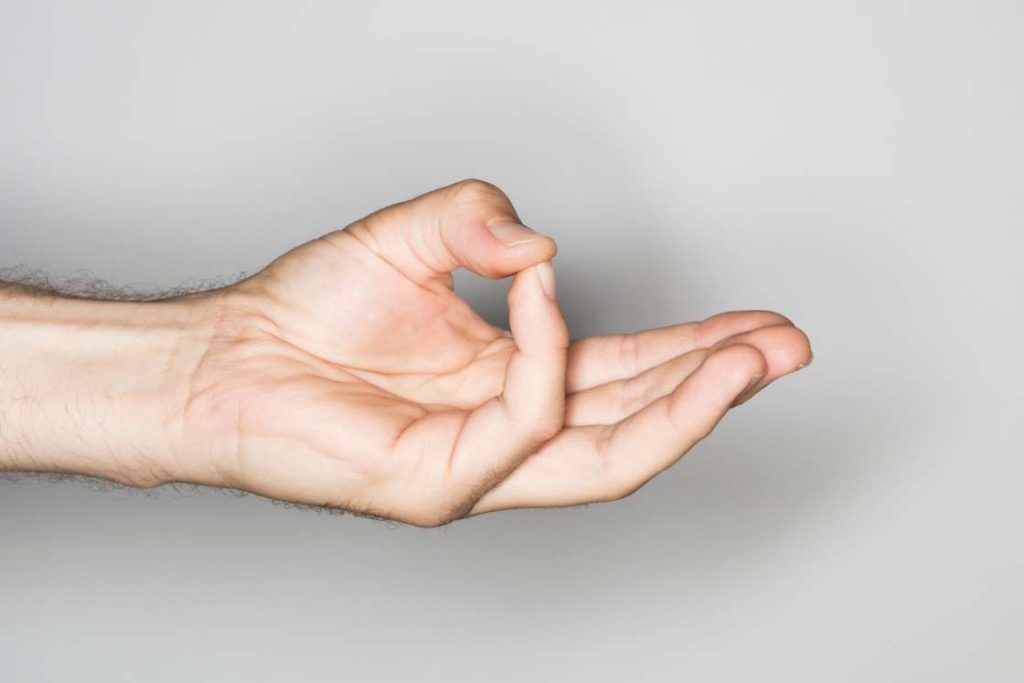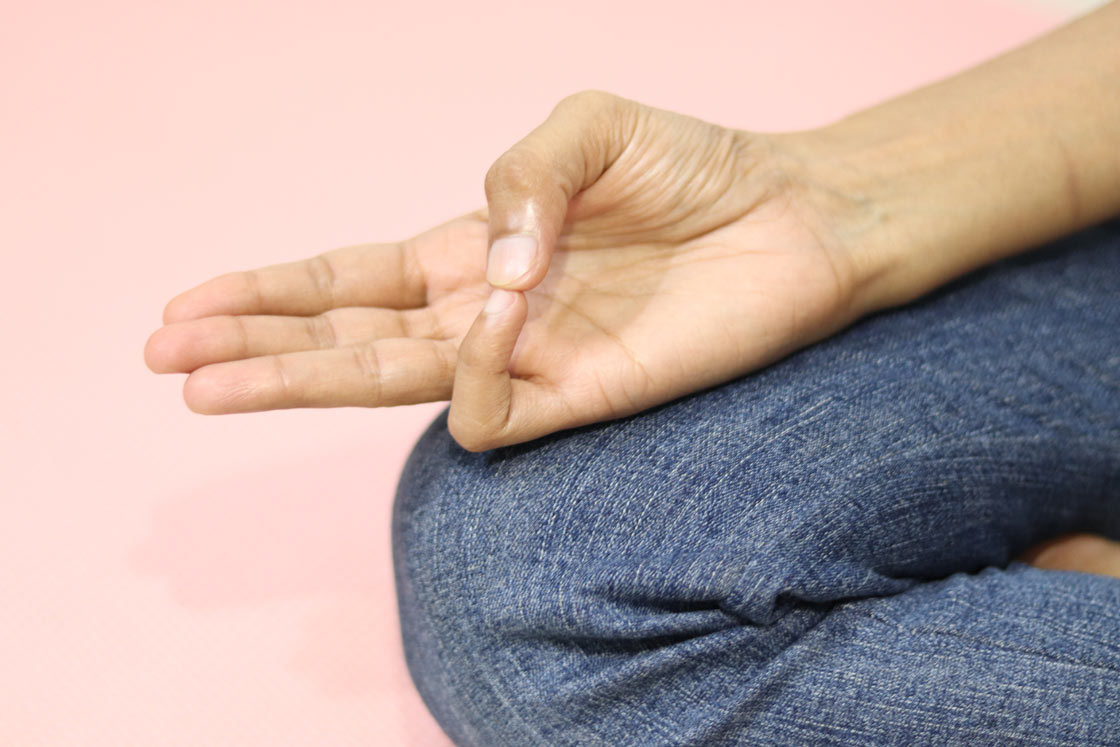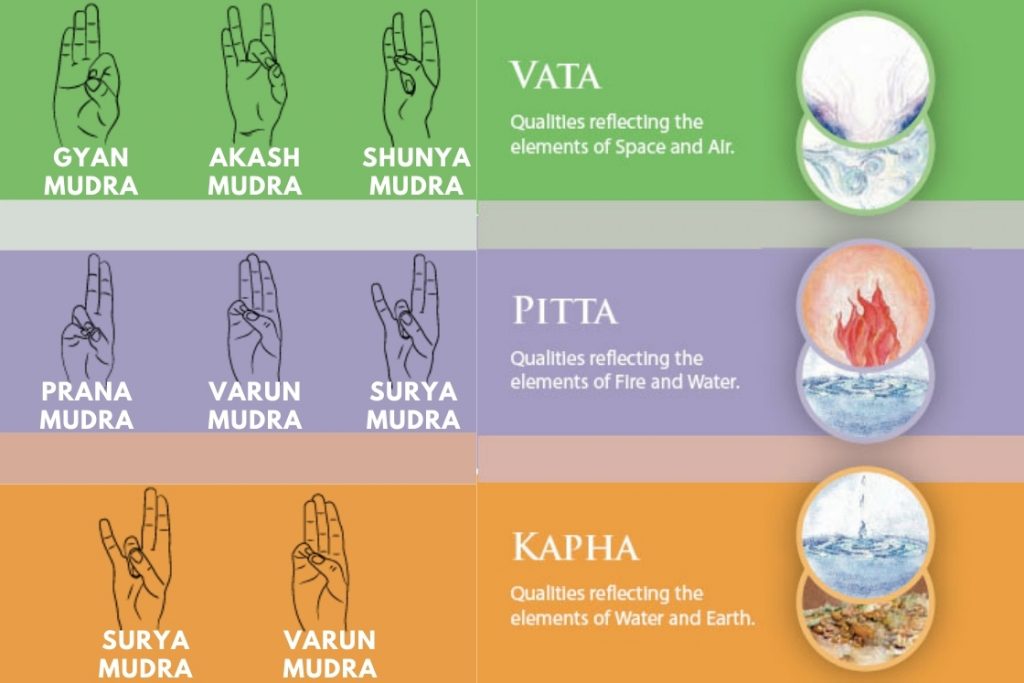
The word mudra is one of the common Sanskrit words in yoga which is derived from Mud and Dhra meaning ‘bliss’ and ‘dissolving’. It has a deep meaning but loosely it is translated as ‘that which dissolves duality and brings forth the bliss’.
Various hand mudras in yoga represent one or more of the five elements of the body (ether, air, fire, water, and earth) based on the position of the fingers.
Varun mudra is mudra of water element.
In this article, we will explore the benefits of Varun Mudra, its therapeutic uses, and how to perform it correctly.
What is Varun Mudra?
Varun Mudra is a hand gesture that promotes water content in the body. It is formed by joining the pinky fingertip to the thumb tip while keeping the other three fingers straight.
Varun Mudra is also called ‘Jal Vardhak Mudra‘ in Sanskrit, which literally means “water enhancer mudra.” If there is a scarcity of water in your body, practicing Varun Mudra is highly beneficial for increasing the body’s water content.
Water is also a symbol of freedom and fluidity because of its flowing nature. Emulating this quality of water, Varun Mudra brings mental clarity and calmness. Hence, it is also called the ‘seal of mental clarity.’
Water constitutes a significant portion of our body and is present in all organs, blood cells, hormones, enzymes, digestive juices, and more. Varun Mudra helps protect the body from water-related issues such as dehydration, fatigue, obesity, and skin dryness
Also read: Mudras to get glowing skin
How to Do Varun Mudra?

To make varun mudra, first straighten your fingers then bend your little finger in such a way that the tip of the thumb touches the tip of the little finger. keep the rest three fingers straight. Make this gesture with both hands.
As varun mudra balances the level water element, it can be performed any time of the day, especially when the body feels dehydrated. During summers or on a sunny day, you can practice this mudra to keep your body nourished and cool.
The practice duration for Varun Mudra should be at least 20-30 minutes a day. Either practice it at a stretch in one sitting or divide it into 2-3 sessions of 10-15 minutes throughout the day.
If you want to regularize Varun mudra practice in meditation, follow these steps;
- Sit in your preferable meditative position such as Sukhasana (easy pose) or Padmasana (lotus pose). Take the time to settle in your position and keep your head and back straight.
- Close your eyes & bring your hands to your knees with the palms facing upwards.
- Join the tip of the thumb to the tip of the little finger on both hands. The rest of the fingers will remain relaxed yet straight.
- Practice this mudra for 10-15 minutes.
- Separate your fingers gently after your session is over but do not get up immediately.
- Stay seated for a couple of minutes, with your eyes closed, and slowly get aware of your surroundings.
Precautions and Contraindications
Do not practice varun mudra if you have problems like swelling, bloating, or puffiness, which is often caused by water retention. It may show adverse side effects when done in such conditions.
- When you are having cough and cold, avoid doing varun mudra. It may worsen your cough symptoms.
- People with Pitta and Kapha dosha should be cautious of practising varun mudra as it can lead to an imbalance of the water element in their bodies.
- Don’t press the tips too hard. It would hurt and be a cause of distraction in your practice.
Varun Mudra Affects on Five Elements and Dosha

Out of the five elements, Varun Mudra directly affects the water element.
The little finger represents the water element in the body. In Varun Mudra, when the thumb contacts the little fingertip, it boosts the water element associated with the little finger.
Varun Mudra is directly linked with Kapha and Pitta doshas, as water is a common element in both. The water element is usually increased in individuals with Kapha or Pitta doshas. Since their water content is already high, people with these doshas should practice Varun Mudra in moderation.
On the other hand, individuals with Vata dosha often lack water content. Therefore, a person with Vata dosha can greatly benefit from Varun Mudra, as it can counteract skin dryness, dehydration, and other issues arising from imbalanced space and earth elements. It also helps people with excess internal heat cool down their bodies.
Also read: Mudras for balancing Vata, Pitta and Kapha dosha
Benefits of Varun Mudra
- Keeps the body hydrated. Varun mudra re-hydrates body tissues at cellular level and provides relief from a range of disorders like constipation, dehydration, polyuria (frequent urination), etc.
- Balances the water content. Regular practice of varun mudra keeps the water content of your body in equilibrium. This will provide relief from oliguria (lack of urination), oligospermia (low semen), oligomenorrhoea (short menstruation), anemia (low hemoglobin), gastroenteritis, etc.
- Helps in reducing cholesterol. Varun mudra is helpful in reducing cholesterol and preventing the onset of stomach ulcers. It does so by regulating the process of elimination, which removes toxic wastes from the body.
- Purifies the blood. Varun mudra prevents the inadequate distribution of water by maintaining healthy circulation of blood vessels. This helps in regular detoxification of the blood and keeps it clean.
- Lubricates the joints. This mudra maintains the water content in the various cartilages, tissues, and muscles, preventing them from degenerating. This in turn reduces the chances of problems like Osteoarthritis.
- Moisturizes dry eyes. Varun mudra keeps the eyes lubricated, preventing dryness in the eyes and blurred vision.
- Helps glow the skin. Varun mudra helps in the distribution of water within the cell and prevents dead skin cells. By the regular practice of varun mudra, the flow of water gets better. This results in clear skin, reduced pimples, and wrinkles. Skin disorders such as eczema, psoriasis, rashes, or petechiae (red or purple spots) can be prevented by varun mudra.
- Improves saliva production. Your sense of taste improves with regular practice of varun mudra. It prompts better saliva production which also prevents dryness of the mouth.
- Stimulate Sacral Chakra. Since varun mudra is water element mudra, it gives power to the sacral chakra. Thus practising varun mudra alleviates any deficiency caused by imbalances of sacral chakra.
- Counters Vata imbalance. If you are a Vata person, then practising this mudra is very helpful for you to cure problems like dehydration, dryness of the skin & joint pain.
Conclusion
Practicing Varun Mudra can provide a plethora of benefits, particularly for your skin, eyes, and blood. Your organs and bones will function properly if the water content in your body is maintained at an optimal level. Water plays a crucial role in detoxification and purification, and Varun Mudra can be immensely beneficial in keeping this process active.





Namaste. Great article! Varuna mudra followed by Prana mudra would give even greater benefits.
Can I perform varuna mudra everyday? That is during summer and winter?
Hello presently I have Cronic Kidney Disease stage 4 and my hemoglobin is low 104 and my creatinine is 284, what type of mudra do you recommend
Kidney mudra
Near the end it says water element is related to ring finger. Was that a typo or do i misunderstand?
It was a typo. The water element is associated with the little finger only. Thanks for mentioning; it’s now corrected.
Do you think varun or prithvi is best to reduce heat in the body?
Yes, both varun mudra and Prithvi mudra are good to reduce heat effects in the body.
Can you please suggest which of the below mudras are safe during pregnancy?
Vyana, Hridaya/Apana vayu mudra, Apana mudra, Gyana, Yoni, Shunya Vayu, Prithvi, Varuna, Rudra, Udana, Samana, Surabhi, Kundalini, Jal Shaamak, Garuda, Ushas
Most of these mudras are safe during pregnancy. However, to better assist I suggest you do Gyana, Apana, Apana vayu, Akash, Yoni, kundalini, jal shaamak, and Ushas Mudra. These mudras will help with most of the complications of pregnancy. Avoid doing prithvi mudra.
Hi, can I consult a specialist for my ailment?
Yes.
Dear Fitsri Experts,
Can you Please suggest, hast Mudra for controlling the Thyroid? On various websites, it is recommended UDANA MUDRA. But on Fitsri website, there is no mentioning. May Please guide.
Best Regards
Yes, Udana Mudra is good for the thyroid. Apart from this, Surya Mudra and Shankh Mudra improves thyroid and parathyroid function.
For dry skin, itching, red skin, and rashes I am doing Varun mudra see my narration of august above. It has not improved at all or rather aggravated. Will you advise to continue or do some other Mudra
THANKS
Varun Mudra increases Pitta. If you are a Pitta Prakriti the skin problem may get aggravated. Please check for your Prakriti before doing Varun Mudra.
Sir mujhe pehle 2yrs back pleurisy tha ab cure ho gaya hai….tho kya ab mai varun mudra karsakte hu
Yes, you can do it. Even Varun mudra is an effective gesture in pleural effusion.
is it okay to practices Varun mudra by one hand? either by the left or right hand, whichever is free?
Yes, it’s totally okay to practice Varun mudra with one hand alone.
Thanks for responding !
I am doing Varun Mudra for the last 8 weeks for having dry skin, rashes, itching, etc….There is no improvement. what do you think the time it should take to improve my condition. I do it for 40-45 min. in the morning after yoga. I am a super senior citizen THANKS How many different mudras one can do in a day. I do Pushan Mudra in Vajarn Asana after meals 20 minutes each time {40 MIN} for getting rid of Constipation.
Varun mudra works great to restore the optimum level of moisture in the body so good for dry skin..It’ll surely work, though sometimes it takes longer based on the body type and its composition.
You can do a number of mudras in a day for different purposes (as long as you’re comfortable with it). Pushan mudra is a good choice for the constipation issue. You’re doing great sir ?
Can a Glaucoma patient practice Varun Mudra?
Yes, Varun mudra is effective in the case of Glaucoma.
As varun mudra increases water content of body, can this be useful to increase the amniotic fluid in pregnant women?
Yes, Varun mudra during pregnancy is only advised in the case of low amniotic fluid. For more detail, here you can check this thread of baby center.
ya .. I had tried this when I had low amniotic fluid during my pregnancy… the doctor was surprised to see an increase in amniotic fluid within 10 days along with ARG powder ….!!
I became intensely emotional while doing this mudra. I was crying inexplicably. Is that a side effect?
I am not sure about it. You should check this for a few times & then you will be sure if this crying is happening because of Varun mudra.
My rash seems to have increased after doing Varun mudra. Is that normal?
Unfortunately, we didn’t face this after performing Varun mudra. It can be a symptom, but we are not sure about it! As soon as We come to know something about this, will inform you by email.
In trying to understand the principles of mudra, is it the energy that would normally flow out ihe body is redirected back into the body via each finger and or thumb?
2. Are there toe mudras? If yes. can you give an example of one useful for the elderly.
Yes, you got it right. Mudras redirect energy back in our body by creating a closed-loop of fingers.
There are some toes mudra as well in yoga that we’ll discuss in Kaya Mudra section.